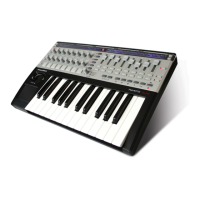67
REL2 (Relative 2):
This is similar to the ‘REL1’ setting however it includes encoder acceleration. A message with
value 64+n is sent out for every clockwise step (increment) and a message with value 64-n is sent out for every anti-
clockwise step (decrement). The value n depends on how fast you rotate the encoder. It will be 1 when you rotate it
slowly and get larger the faster you rotate it, meaning that you can scale the full range of a parameter with a small
quick turn of an encoder.
0-16K (14-bit mode):
MIDI data values are transmitted as a 7-bit binary number, allowing a maximum value range of
0-127. The MIDI Specification allows for two MIDI control messages to be sent together where the data values form an
MSB (most significant byte) and LSB (least significant byte) pair, making a 14-bit binary number and allowing a maximum
value range of 0-16383. This is useful where fine control over a parameter is required, however the parameter you
are controlling must be able to receive 14-bit MIDI values. If you want to send 14-bit values for fine control over a
parameter then set DispType to ‘0-16K’.
For CC controls, the MIDI Specification only allows for CC numbers 0 to 31 to be used in this way. Two CC messages
are sent when the value of a parameter is changed – the first with the MSB value and the second with the LSB value.
To enable the receiving device to distinguish between which CC message has the MSB value and which has the LSB
value, the LSB value message is sent using a different CC number, calculated by adding 32 to the original CC number.
Consequently CC numbers 32 to 63 are used for sending the LSB value in 0-16K (14-bit) mode. As an example, if a CC
encoder has DispType set to ‘0-16K’ and CC Num set to 0 then, for each encoder step, two messages will be sent – a
CC0 message with the MSB value and a CC32 message with the LSB value. The important point to note is that if an
encoder has Control set to ‘CC’ and DispType set to ‘0-16K’ then CC Num should only be set from 0 through 31 and
not higher.
APOT: This is a variation of ‘REL2’ and is the same system that is used by some other existing popular control surfaces.
A message with value 0+n is sent out for every clockwise step (increment) and a message with value 64+n is sent out
for every anti-clockwise step (decrement). The value n will equal 1 when you rotate the encoder slowly and increases as
you rotate the encoder faster.
Additional options for buttons only:
ON/OFF: Control value displayed as either ON or OFF. The low value setting determines the ON value and the high value
setting determines the OFF value. This is best suited to a bi-state parameter where you want to see whether it is in an
on or off state e.g. phase reverse on a mixer channel.
LED:
This is like ON/OFF except that nothing is displayed when the control is in an OFF state.
Additional option for when Control is set to ‘NoContrl’:
LABEL: If a control is not assigned to send a MIDI message then no information will be displayed for it in Play mode and
there will be a blank space above it on the display. You can however use that blank space to display up to 8 characters
(on the top line of the display) by setting DispType to ‘LABEL’. If this is set, the control name will be displayed, even
though the control is not assigned to anything. You can edit the control name by scrolling up to the second page of
options in Edit mode (see below for further info on editing control names).
LowVal (Low Value) and HighVal (High Value):
These options allow you to set the upper and lower limits of the control
value. By default the Low Value will be set to the lowest possible value and the High Value will be set to the highest possible
value. In this case the control will affect a parameter throughout its whole range. Adjust these settings if you want the
control on the ReMOTE SL to affect a parameter though only part of its range.

